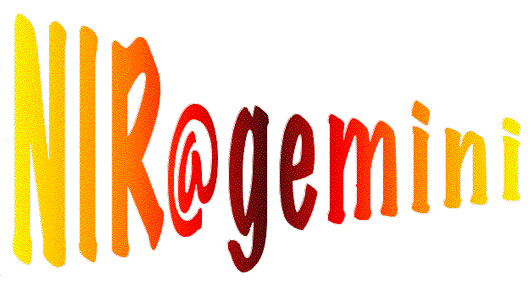
| You are in: Instruments > NIR > Spectral Templates |
 |
 |
Spectral Templates - Late type stars at 2.15-2.43μm
|
Spectral templates (usually late type stars) are required for the
analysis of kinematical data on external galaxies (or other stellar
ensembles). In the near-IR, the most commonly used features are the CO
overtone bands at lambda > 2.3μm. Although observational and
theoretical libraries exist at lower spectral resolutions (R<3000),
no comprehensive set of stellar kinematic templates was available to
be used with two of the configurations of Gemini NIR instruments used
for stellar population kinematic studies in external galaxies - NIFS
and GNIRS 111 l/mm grating (both longslit and IFU) - and all
programmes using those configurations would invariably spend some
science time taking a small set of stellar spectra to use as
templates. This led to a constant duplication of data taking, since
those targets are programme calibrations and are not made available to
other users until the end of the default 18 months proprietary
period.
During semester 2006B at Gemini South, given the extraordinarily
poor conditions over the whole semester, and the eventual end
of true "poor weather" programmes in the queue, a Director's
Discretionary "poor weather" programme was carried out to provide the
NIR community with a larger set of late (F7 to M3; types I,
II, III and V) stellar spectra, with intermediate S/N (30-50),
including the four CO overtone bands (2.24-2.42μm) at R~6000
resolution. A subset of the targets was also observed at a slightly
bluer spectral range to improve usefulness for NIFS users, overlapping
with the red setting on the first two CO bands.
Quick Links:
Library Description
| The
GNIRS library of late spectral templates |
|
| Instrument
configuration |
GNIRS
IFU+111 l/mm grating in the K band |
| "Red"
setting |
λc=2.335μm
(2.24-2.43μm), dλ=1.84 Å/pixel FWHM (arc lines) = 1.82 pixel |
| "Blue"
setting |
λc=
2.245μm (2.15-2.33μm), dλ=1.85 Å/pixel FWHM (arc lines) = 1.88 pixel |
| combined
spectrum |
2.15-2.43μm,
rebinned to dλ = 1 Å/pixel |
| Observed
sample |
29
objects in the "red" setting, from F7III to M3III Of these, 23 objects were also observed in the "blue" setting |
The observed sample was selected from a list kindly provided
by Greg Doppmann, compiled from the literature (mostly based in Cayrel
et al 1997), and the selection was based exclusively on observability:
targets which were visible for as long as possible during the 06B
semester, bright enough to provide the desired S/N on a reasonable
on-source time under CC=90, IQ=ANY conditions, and having a hot (A0-A7)
star close enough (and bright enough!) to be used for telluric
correction. The fact that both target and telluric stars also had to
have a bright (V<13mag) guide star available as well, restricted
even more the choices.
The observing conditions also determined the instrument
configuration: to achieve R=5900 with GNIRS in long slit mode, one
would have to use the 0.30" slit - implying in very large slit losses
under IQ=Any (FWHM>0.80" in K) seeing. Given the superior GNIRS IFU
performance in the K band (over 90% of that of the equivalent long
slit mode), there was only a small loss in sensitivity by using the
IFU+111 l/mm grating configuration. On the other hand, the small
field-of-view of the IFU required the observations to be carried out
in a object-sky-sky-object pattern, but even with a 50% reduction in
on-source time, this setup still proved to be very efficient at
the telescope.
All data collected for this programme (GS-2006B-DD-3, PI: Winge)
has been made public in the Gemini
Science Archive. This page contains links to the table of final
processed spectra, details of the data reduction, and some examples of
the template use with actual GNIRS and NIFS science data. The
community at large is welcome to download all or part of the library
as needed, and users of GNIRS or NIFS are encouraged to explore its
use as an alternative to requesting further observation of spectral
standards with their science programmes. If the raw data are
re-processed to be used in papers or publications, please use the
standard Gemini acknowledgement text and the above programme ID. For
the processed data contained in this page, the authors would
appreciate acknowledgement of the library use (Winge, Riffel and
Storchi-Bergmann (in preparation), please point to this URL until the
actual paper appears).
The data are presented in standard FITS format, and the
user can
select either the red (2.24-2.42μm) or blue
(2.15-2.32μm) spectral
ranges at their native spectral binning; or the combined spectrum
(when both ranges were observed), rebinned to 1 Å/pix.
As
the data reduction progressed, I realized that several steps could
be improved, but rather than
go back and reprocess everything, the decision was to publish the
library and
implement subsequent changes in the form of new release versions.
Current release is Version 1.0.
The authors would like to thank the Gemini Deputy Director and Head of Science, Jean-Rene Roy, and the Gemini South Head of Science Operations, Michael West, for the support and time allocation for this programme. Many thanks as well to all the Gemini South observers and SSAs that so positively believed that no conditions were ever too poor to give GS-2006B-DD-3 a chance!
2007 Apr 10 - Version 1.0 uploaded to the
Gemini Web Site.
Last update 2007 April 09; Claudia Winge